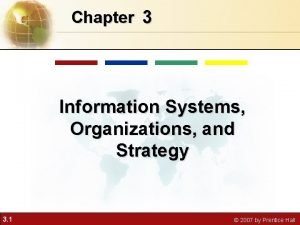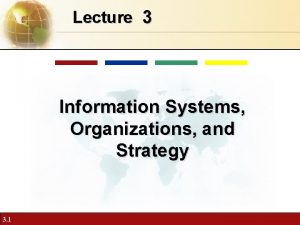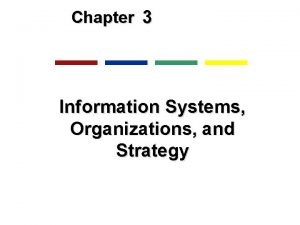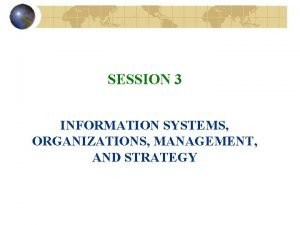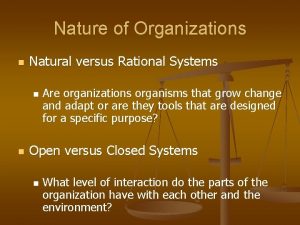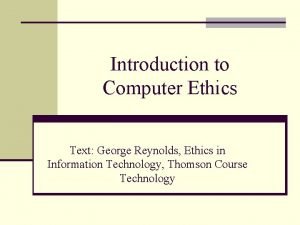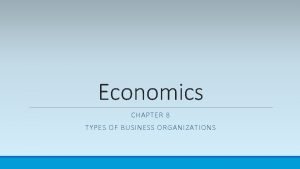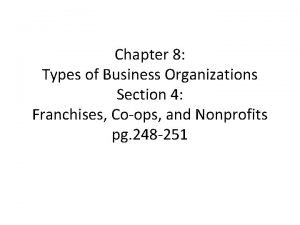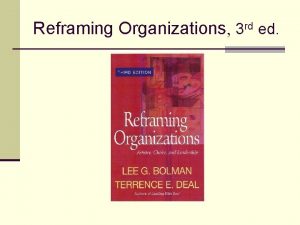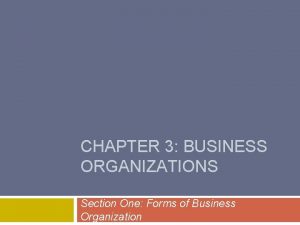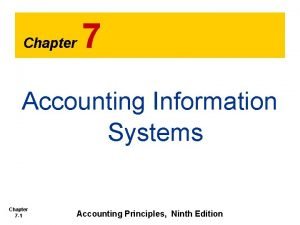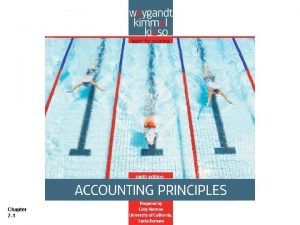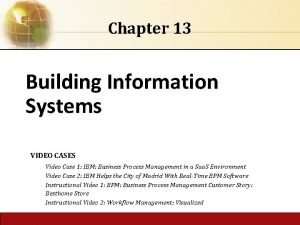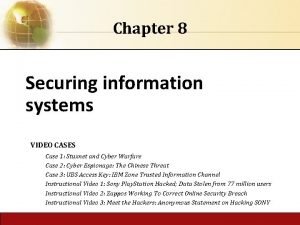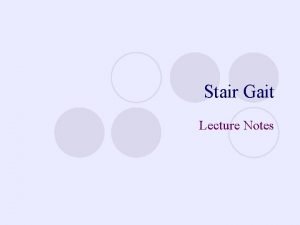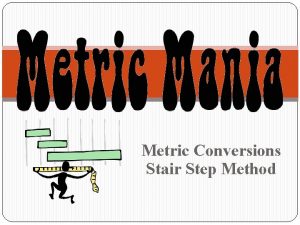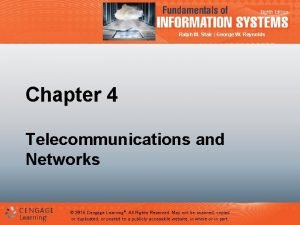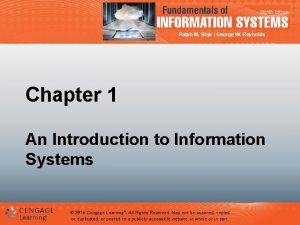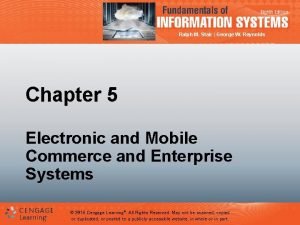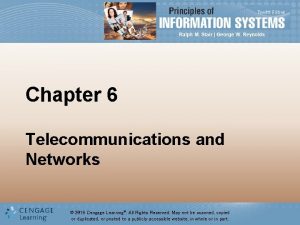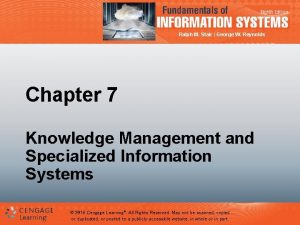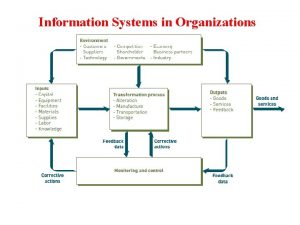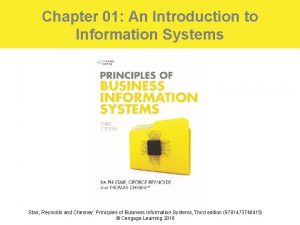Chapter 02 Information Systems In Organizations Stair Reynolds





















- Slides: 21

Chapter 02: Information Systems In Organizations Stair, Reynolds and Chesney: Principles of Business Information Systems, Third edition (9781473748415) © Cengage Learning 2018

Principles • The use of information systems to add value to the organization is strongly influenced by organizational structure, and the organization’s attitude and ability to change • Because information systems are so important, businesses need to be sure that improvements to existing systems, or completely new systems, help lower costs, increase profits, improve service, or achieve a competitive advantage • Cooperation between business managers and IS personnel is the key to unlocking the potential of any new or modified system For use with Principles of Business Information Systems, 3 e by Stair, Reynolds & Chesney © 2018 Cengage Learning

An introduction to organizations • An organization is a formal collection of people and other resources established to accomplish a set of goals • An organization is a system, which means that it has inputs, processing mechanisms, outputs, and feedback • Resources such as materials, people, and money are the inputs • These go through a transformation mechanism, the processing • The outputs from the transformation mechanism are usually goods or services, which are of higher relative value than the inputs alone • Through adding value or worth, organizations attempt to achieve their goals For use with Principles of Business Information Systems, 3 e by Stair, Reynolds & Chesney © 2018 Cengage Learning

The value chain • The value chain is a useful tool for analyzing where and how this value gets added • The value chain is a series (chain) of activities that includes inbound logistics, warehouse and storage, production, finished product storage, outbound logistics, marketing and sales, and customer service • The value chain is used to examine what happens to raw material to add value to them before the finished product gets sold to customers • Information systems can be developed to focus on those activities that add the most value For use with Principles of Business Information Systems, 3 e by Stair, Reynolds & Chesney © 2018 Cengage Learning

SRM & CRM • Supply chain management (SCM) and customer relationship management (CRM) are two key parts of managing the value chain • SCM helps determine what supplies are required for the value chain, what quantities are needed, how they should be turned into finished products and shipped to customers • Increasingly, SCM is accomplished using the Internet and B 2 B e-commerce • CRM programs help a company manage all aspects of customer encounters, including marketing and advertising, sales, customer service after the sale, and help retain loyal customers For use with Principles of Business Information Systems, 3 e by Stair, Reynolds & Chesney © 2018 Cengage Learning

IS in SCM & CRM • What role does an information system play in SCM & CRM? • A traditional view of information systems holds that organizations use them to control and monitor processes and ensure effectiveness and efficiency • A more contemporary view, however, holds that information systems are often so intimately involved that they are part of the process itself • This gives a new perspective on how and why businesses can use information systems • Managers should consider the potential role of information systems within business processes, which often leads to the discovery of new and better ways to accomplish the process For use with Principles of Business Information Systems, 3 e by Stair, Reynolds & Chesney © 2018 Cengage Learning

Organizational structures • Organizational structure refers to organizational subunits and the way they relate to each other. An organization’s structure depends on its approach to management, and can affect how it views and uses information systems • The types of organizational structures typically include: – Traditional – project & team – virtual For use with Principles of Business Information Systems, 3 e by Stair, Reynolds & Chesney © 2018 Cengage Learning

Traditional organizational structure • This is a managerial pyramid where the hierarchy of decision making and authority flows from the strategic management at the top, down to operational management and non-management employees • Those at the top have a higher degree of decision authority, more impact on business goals, and more unique problems to solve • Today, the trend is to reduce the number of management levels, or layers, in the traditional organizational structure • This type of structure is often called a flat organizational structure For use with Principles of Business Information Systems, 3 e by Stair, Reynolds & Chesney © 2018 Cengage Learning

Project and team organizational structures • A project organizational structure is centred on major products or services • Each major product has its own marketing, finance and production departments • The team organizational structure is centred on work teams or groups • Teams can be small or large, permanent, or temporary • A healthcare company, for example, could form small teams to organize its administrators, doctors, and others to work with individual patients For use with Principles of Business Information Systems, 3 e by Stair, Reynolds & Chesney © 2018 Cengage Learning

Virtual organizational structure • A virtual organizational structure is made up of individuals, teams, or complete business units that work with other individuals, teams, or complete business units in different geographic locations • This almost always requires the use of the Internet (or other telecommunications) to facilitate communication • The people might never meet physically, which is why they are called virtual • A company can use a virtual organizational structure with its own dispersed workers who have distinct skills and abilities to reduce costs For use with Principles of Business Information Systems, 3 e by Stair, Reynolds & Chesney © 2018 Cengage Learning

Organizational change • Most organizations are constantly undergoing change, both minor and major • The need for organizational change can come from new managers, staff leaving, activities wrought by competitors or stockholders, new laws, natural occurrences (such as a hurricane), and changes in general economic conditions • An new IS will cause change • When a company introduces a new information system, a few members of the organization must become agents of change – champions of the new system and its benefits • Understanding the dynamics of change can help them confront and overcome resistance so that the new system can be used to maximum efficiency and effectiveness For use with Principles of Business Information Systems, 3 e by Stair, Reynolds & Chesney © 2018 Cengage Learning

Reengineering and continuous improvement • To stay competitive, organizations must occasionally change the activities, tasks, or processes they use to achieve their goals • Reengineering, also called process redesign and business process reengineering (BPR), involves the radical redesign of business processes, organizational structures, information systems, and values of the organization to achieve a breakthrough in business results • Continuous improvement involves constantly seeking ways to improve business processes and add value to products and services For use with Principles of Business Information Systems, 3 e by Stair, Reynolds & Chesney © 2018 Cengage Learning

Comparing BPR and continuous improvement For use with Principles of Business Information Systems, 3 e by Stair, Reynolds & Chesney © 2018 Cengage Learning

User satisfaction and technology acceptance • To be effective, reengineering and continuous improvement efforts must result in satisfied users and be accepted and used throughout the organization • Technology diffusion is a measure of how widely technology is spread throughout an organization. An organization in which computers and information systems are located in most departments and areas has a high level of technology diffusion • Technology infusion is the extent to which technology permeates an area or department. In other words, it is a measure of how deeply embedded technology is in an area of the organization • An organization might have a high level of diffusion and infusion, but this does not necessarily mean that information systems are being used to their full potential For use with Principles of Business Information Systems, 3 e by Stair, Reynolds & Chesney © 2018 Cengage Learning

The applications portfolio • The applications portfolio classifies information systems according the contribution they make to the business: Support applications are nice to have, but not essential Key operational applications are essential and without them, the organization would not be able to do business Strategic applications are information systems that give a business an advantage over some or all of its competitors Potential strategic application (also known as a future strategic or high potential application) is an idea for, or a prototype of, an information system which, if developed, might one day become a strategic system • The portfolio is used to visualize what systems are currently in use, and plan out new development projects For use with Principles of Business Information Systems, 3 e by Stair, Reynolds & Chesney © 2018 Cengage Learning

Success factors • It is of vital importance that a company’s information systems are aligned with the company’s goals • The main way of achieving alignment is for senior managers to consider the business processes they have in place to achieve company goals, and ask, what information systems are needed to support these business processes • Less frequently a business, typically a small business or even a single entrepreneur, will consider what technology is available to them and ask, what business goals can be achieved with it • Other success factors include: – – Senior management must be committed End-users of the system should be involved in the development Time must be taken to carefully determine requirements Strong project management For use with Principles of Business Information Systems, 3 e by Stair, Reynolds & Chesney © 2018 Cengage Learning

Competitive advantage • A competitive advantage the ability of a firm to outperform its industry, that is, to earn a high rate of profit than the industry norm • It can result from higher-quality products, better customer service, and lower costs • Often, a competitive advantage will depend on a carefully designed information system For use with Principles of Business Information Systems, 3 e by Stair, Reynolds & Chesney © 2018 Cengage Learning

Evaluating IS • Once an information system has been implemented, management will want to assess how successful it has been in achieving its goals. Often this is a difficult thing to do, and many businesses do not attempt to take anything more than an informal approach to evaluation • Some approaches to evaluating IS include: – – – Productivity: examine how output has changed since implementation Return on Investment: examine how profits have increased Earnings Growth: another measure of profit increase Market Share: examine the change in market share since implementation Customer Awareness and Satisfaction: possibly qualitative measure of satisfaction – Total Cost of Ownership: estimate the total cost of the IS breaking cost into areas such as the cost to acquire the technology, technical support, administrative costs, and end-user operations For use with Principles of Business Information Systems, 3 e by Stair, Reynolds & Chesney © 2018 Cengage Learning

Careers in Information Systems • Chief Information Officer • LAN administrators • Internet Careers: Web operations, Web development, and Web administration • System developers • Technical writing • User interface design • Database administration For use with Principles of Business Information Systems, 3 e by Stair, Reynolds & Chesney © 2018 Cengage Learning

Summary • An organization is a system – has inputs, processing mechanisms, outputs, and feedback • Categories of organizational structure: traditional, project, team, and virtual • Reengineering: radical redesign of business processes, organizational structures, information systems, and values of the organization to achieve a breakthrough in business results • Continuous improvement: constantly seeking ways to improve business processes For use with Principles of Business Information Systems, 3 e by Stair, Reynolds & Chesney © 2018 Cengage Learning

Summary (continued) • Productivity: a measure of output achieved divided by input required • Primary responsibilities in information systems: operations, systems development, and support • Typical IS titles: Chief Information Officer (CIO), LAN administrators, Internet strategists and administrators, Internet systems developers, Internet programmers, and Internet or Web site operators For use with Principles of Business Information Systems, 3 e by Stair, Reynolds & Chesney © 2018 Cengage Learning
 Chapter 3 information systems organizations and strategy
Chapter 3 information systems organizations and strategy Information systems, organizations, and strategy
Information systems, organizations, and strategy Information systems, organizations, and strategy
Information systems, organizations, and strategy Information systems, organizations, and strategy
Information systems, organizations, and strategy Information systems organizations and strategy
Information systems organizations and strategy Natural organization
Natural organization Ethics in information technology reynolds
Ethics in information technology reynolds Chapter 8 business organizations
Chapter 8 business organizations Section 4 other organizations
Section 4 other organizations Chapter 8 section 4 other organizations
Chapter 8 section 4 other organizations Chapter 1 introduction to management
Chapter 1 introduction to management Reframing organizations chapter 3 summary
Reframing organizations chapter 3 summary Chapter 3 business organizations
Chapter 3 business organizations Functions of an information system
Functions of an information system Chapter 8 securing information systems
Chapter 8 securing information systems Chapter 8 securing information systems
Chapter 8 securing information systems Chapter 7 accounting information systems
Chapter 7 accounting information systems Chapter 7 accounting information systems
Chapter 7 accounting information systems Dfd ch 13
Dfd ch 13 Chapter 8 securing information systems
Chapter 8 securing information systems Principles of information systems
Principles of information systems Fundamentals of information systems chapter 1
Fundamentals of information systems chapter 1

